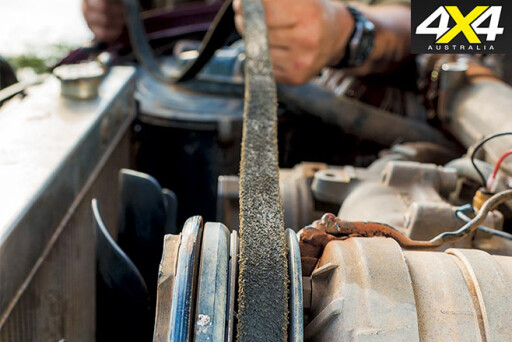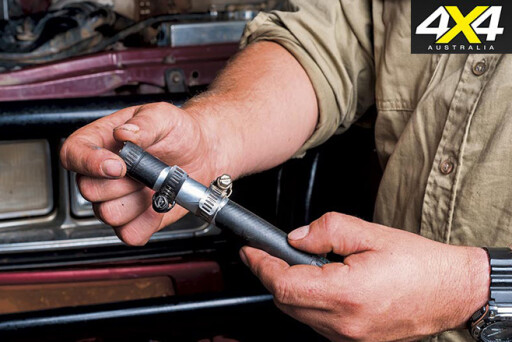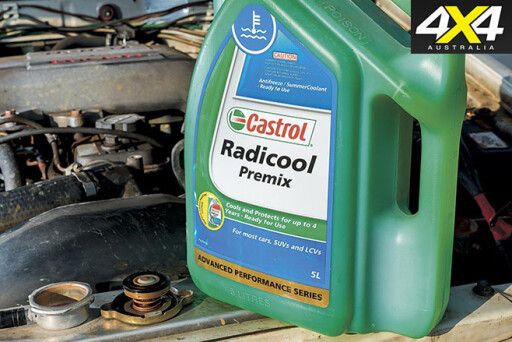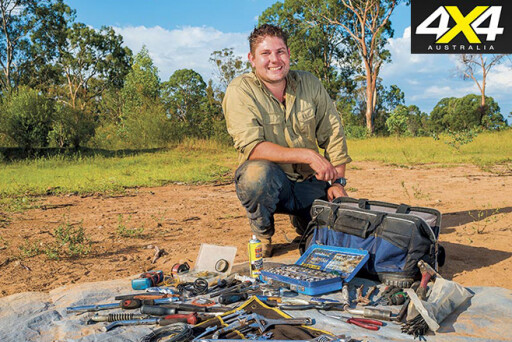
As 4WDers, our off-road adventures can lead us to some pretty spectacular places. To get to the best of them usually means you’ve got to tackle some pretty hard-going terrain, which is why we have 4x4s in the first place.
The problem is, things such as soft sand, heavy loads and hot climates can really get your engine working overtime, which puts its cooling system to the test. And when you’re in the middle of nowhere, the last thing you want is for your engine to overheat and call it quits; it doesn’t take long for heat to destroy an engine.
To help you catch and fix any cooling issues that arise while you’re out on the tracks, here are some proven tips, tricks, techniques and fair-dinkum bush fixes to get you back out there exploring once again.
MAKESHIFT FAN BELTS

If you snap your water pump’s drive belt, there are a few ways to construct a makeshift replacement. The material you use needs to have enough grip to rotate the pulleys, while also being durable enough to be tightened up without stretching and breaking.
One proven material to use is some old pantyhose – simply twist them up, wrap them around the pulleys nice and tight, and tie the ends together. Alternatively, a leather belt, dog lead, bailing twine or a nylon strap will get the job done. Remember to back the adjusters off before you start, so you can adjust it tighter after you tie the knot.
LEAKY HOSES

There are a few different options when it comes to patching up a leaking hose, but one of the simplest methods is the old soft-drink-can trick. For this, you simply cut the can into a strip, wrap it tight around the punctured area and secure it with hose clamps – even cable ties will work in a pinch. Adding a dab of sealant on top works a treat, too. Another technique is to cut the punctured bit out and re-join the hose via a pipe with hose clamps.
Get creative here – you’ll have all sorts of things lying around that can get the job done – a pen housing for small hoses, a generic handpump tap nozzle or even a piece of a camp chair leg can be cut down and used.
TEMP GAUGE ACCURACY

It may seem crazy but some factory temperature gauges aren’t designed to give you an accurate reading. For example, the needle on your typical 80-series LandCrusier gauge will sit around halfway, while the actual temperature could really range anywhere from 40-100°C.
Manufacturers do this so we don’t get too concerned about completely normal momentary temperature spikes. However, it does mean your engine could be running hotter than usual, and you wouldn’t have a clue until it overheats. Fitting a secondary aftermarket gauge means you can monitor exactly where your engine temps are at and catch a potential problem early.
RADIATOR TUBE REPAIRS
If a stick manages to fling up and damage your radiator’s main tubes (they hold the coolant) you’ll end up with a leak. For smaller punctures, you might get away with smearing some sealant or epoxy putty over the hole. However, for badly damaged tubes, you’ll most likely have to remove the radiator to gain better access. The idea is to sever the damaged tubes in half, roll up the ends and reseal. Then use sealant or epoxy putty to keep it wound tight.
BLOCKED THERMOSTAT

The purpose of a thermostat is to regulate the flow of the water in your engine’s cooling system. It does this by blocking the flow altogether when the engine is cold, so the water doesn’t circulate through the radiator and get cooled by the flow of air. As the engine heats up, the thermostat opens and allows water to circulate through the radiator for cooling. This means that both the inlet and outlet coolant hoses should be hot to touch when the engine is at operating temperature.
If one of the hoses is hot and the other is still cool, it indicates that the thermostat is stuck closed. To get you out of trouble, the easiest fix is to simply remove the thermostat altogether. In fact, in most cases, the engine will run cooler than it ever has – too cool to be a permanent modification.
BLOCKED RADIATORS

A tell-tale sign that a blocked radiator is causing your overheating issues is when your temperature creeps up while you’re driving at highway speeds (80-110km/h). The airflow at these speeds should generally be enough to keep the coolant cool.
If you’ve been rolling through thick spinifex (especially up north) remember to give the front of the radiator a blast with compressed air when you get back to camp.
Similarly, if you’ve been playing in the mud, give it a thorough clean with fresh water (using high pressure will damage the radiator fins). And if you’re running a large set of spotlights on the bullbar, try removing them as they can block the radiator’s surface area and restrict airflow more than you’d think.
TYRE PRESSURES
WE all know that appropriate tyre pressures are a big part of four-wheel driving, but did you know that tyre pressure can have an effect on how hot your engine runs? Yep, it’s true – especially when you’re tackling soft sand for a prolonged period of time.
I did a test a little while back where I set my tyre pressures to 19psi and drove on soft sand for 5km. The engine temperature got up to 98°C. I then dropped the tyre pressures down to 14psi and drove the same stretch of sand. The engine temperature sat between 80 and 85°C – that’s a massive difference! That little experiment proved that lowering my tyre pressures by 5psi allowed my engine to run 14°C cooler.
How does it do this? Well, lower pressures create a larger tyre footprint, so tyres float across the top of the sand instead of digging down and making your engine work harder.
ANTI-FREEZE ADDITIVES

It might seem unlikely but it’s actually pretty common to see a punctured and leaking radiator when you’re travelling through sub-zero climates. The reason is simple – if the fluid in your cooling system gets cold enough to freeze, the water will turn to ice and expand, which can rupture the tubes in your radiator. So it’s super-important to run a quality anti-freeze additive to lower the freezing point of the coolant.
COOLING AN OVERHEATING ENGINE
Turn your heater and fan on full – it sounds crazy but hear me out. The heater basically redirects engine and engine bay heat to the outside of your vehicle. At the same time, turn your air-conditioning off, as that places more load on your engine.
Most 4WDs have belt-driven water pumps that run directly off the engine’s crankshaft, which means the higher the revs, the faster the water pump and fan assembly spin. So if you find yourself stuck in slow-moving traffic, steadily increasing your engine’s revs to around 2000rpm will help draw in more air through the radiator to cool the engine quicker.
Vehicles with air-conditioning have an extra fan for the condenser. In extreme scenarios, one option is to power up this fan by rigging it up to a separate circuit. Remember to use a 12-volt relay and a cable large enough to handle the fan’s current draw, and check the polarity is correct so the fan spins the right way.
 PARTING THOUGHTS
PARTING THOUGHTS
If you end up facing a cooling system problem out in the scrub, you’ll need to assess each situation on its own merits, as every vehicle is different, and every location adds a whole new challenge to overcome. Start with the basics and use a bit of common sense. Work out whether the vehicle is drivable or needs to be towed. If you’re going to risk driving it, lighten the load, hitch the camper on the back of your mate’s 4WD, ensure the coolant level is topped up, remove the spot lights and bug catcher that almost always block the wind from penetrating your radiator, and wait to travel when it cools off in the arvo. With a bit of knowledge and lateral thinking, you can get yourself back on track and back in the game in no time at all.


COMMENTS